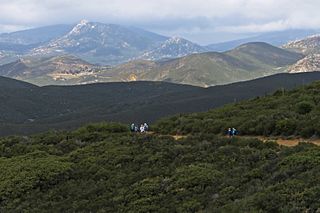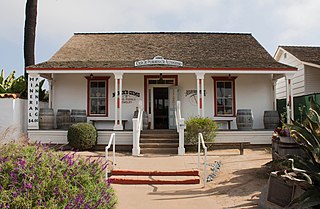
Wyatt Berry Stapp Earp was an American lawman and gambler in the American West, including Dodge City, Deadwood, and Tombstone. Earp was involved in the gunfight at the O.K. Corral, during which lawmen killed three outlaw Cochise County Cowboys. While Wyatt is often depicted as the key figure in the shootout, his brother Virgil was both Deputy U.S. Marshal and Tombstone City Marshal that day and had considerably more experience in law enforcement as a sheriff, constable, and marshal than did Wyatt. Virgil made the decision to enforce a city ordinance prohibiting carrying weapons in town and to disarm the Cowboys. Wyatt was only a temporary assistant marshal to his brother.

The Panama–California Exposition was a world exposition held in San Diego, California, between January 1, 1915, and January 1, 1917. The exposition celebrated the opening of the Panama Canal, and was meant to tout San Diego as the first United States port of call for ships traveling north after passing westward through the canal. The fair was held in San Diego's large urban Balboa Park. The park held a second Panama-California exposition in 1935.

Cuyamaca is a region of eastern San Diego County. It lies east of the Capitan Grande Indian Reservation in the western Laguna Mountains, north of Descanso and south of Julian. Named for the 1845 Rancho Cuyamaca Mexican land grant, the region is now dominated by the 26,000-acre (110 km2) Cuyamaca Rancho State Park. Within the park is the prominent Cuyamaca Peak, the second-highest mountain in San Diego County at 6,512 feet (1,984.9 m).

Balboa Stadium is an outdoor stadium in San Diego, California, located adjacent to San Diego High School. The stadium primarily hosts local football and soccer games. Owned by the City of San Diego, it is leased to the San Diego Unified School District.

Joaquin Murrieta Carrillo, also called the Robin Hood of the West or the Robin Hood of El Dorado, was a Mexican figure of disputed historicity. The novel The Life and Adventures of Joaquín Murieta: The Celebrated California Bandit (1854) by John Rollin Ridge is ostensibly his story.

The Battle of San Pasqual, also spelled San Pascual, was a military encounter that occurred during the Mexican–American War in what is now the San Pasqual Valley community of the city of San Diego, California. The series of military skirmishes ended with both sides claiming victory, and the victor of the battle is still debated. On December 6 and 7, 1846, General Stephen W. Kearny's US Army of the West, along with a small detachment of the California Battalion led by Archibald H. Gillespie, engaged a small contingent of Californios and their Presidial Lancers Los Galgos, led by Major Andrés Pico. After U.S. reinforcements arrived, Kearny's troops were able to reach San Diego.

Campo is an unincorporated community in the Mountain Empire area of southeastern San Diego County, California, United States. The population was 2,955 at the 2020 United States census, up from 2,684 at the 2010 census. For statistical purposes, the United States Census Bureau has defined Campo as a census-designated place (CDP). The census definition of the area may not precisely correspond to local understanding of the area with the same name.

Charles F. O'Neall was a real estate agent and an American Democratic politician from California.

Juan María Marrón was an early settler of San Diego, California.

Katherine Olivia Sessions was an American botanist, horticulturalist, and landscape architect closely associated with San Diego, California. She is known as the "Mother of Balboa Park".

The Black Hills gold rush took place in Dakota Territory in the United States. It began in 1874 following the Custer Expedition and reached a peak in 1876–77.
Juan Flores was a 19th-century Californio bandit who, with Pancho Daniel, led an outlaw gang known as "las Manillas" and later as the Flores Daniel Gang, throughout Southern California during 1856-1857. Although regarded by historians as a thief and outlaw, Flores was considered among Mexican-Americans as a folk hero akin to Jesse James and who was thought of as a defender against vigilante movements in the years following the American settlement of California and its incorporation into the United States. However, the activities of Flores and other insurrectos such as Salomon Pico and Joaquín Murrieta against American and foreign-born settlers not only created long-lasting suspicion and hostility towards Mexican-Americans but also divided the traditional Spanish class structures of the Californios and the poorer peasants as well.

Camp Lockett was a United States Army military post in Campo, California, east of San Diego, and north of the Mexican border. Camp Lockett has historical connections to the Buffalo Soldiers due to the 10th and 28th Cavalry Regiments having been garrisoned there during World War II. It was named in honor of Colonel James R. Lockett who fought in the Spanish–American War, Philippine Insurrection, and the Punitive Expedition. There was an active preservation effort underway with long-term plans of creating the 'Camp Locket Historic District' in the National Register of Historic Places, which ended due to private property concerns. In 2009 it was designated as a California Historical Landmark, and there are plans to create a county park out of the majority of its former area.

Don Juan Temple was a Californian ranchero and merchant. Born in Massachusetts, he emigrated to Alta California in 1827, becoming a Mexican citizen, adopting the Spanish language and a Spanish name, and eventually marrying into a prominent Californio family. After acquiring Rancho Los Cerritos in 1843, he became one of the largest landowners in Los Angeles County.

The Cuyamaca Mountains, locally the Cuyamacas, are a mountain range of the Peninsular Ranges in San Diego County, California. The mountain range runs roughly northwest to southeast. The Laguna Mountains are directly adjacent to the east, with Palomar Mountain and Hot Springs Mountain more distant to the north.

The Ruby Murders is the popular name for three separate incidents involving the deaths of six American citizens near the town of Ruby, Arizona. The first incident occurred in February 1920 when Mexican bandits robbed and killed the two owners of the Ruby Mercantile. A second attack happened in April 1921 when Mexican bandits robbed and killed the store's new owners. Two of the bandits were arrested for the crime, but they briefly escaped custody in July 1922 after killing another two men, which led to the largest manhunt in the history of the Southwest.
Captain Jonathan R. Davis was an American gold rush prospector. On December 19, 1854, he single-handedly killed eleven armed outlaws at Rocky Canyon near Sacramento, California, using two Colt revolvers and a Bowie knife. This episode became one of the deadliest small arms engagements in American history involving one man against multiple foes. American sculptor Michael Trcic depicted the historical event in the sculpture "One Man With Courage is a Majority".
Coleman City, also called Emily City, is a ghost town in San Diego County, California. It lies at an elevation of 3601 feet. It is located on State Highway 78 where it crosses Coleman Creek, about four miles west of Julian.
Casa de Cota site in San Diego, California in San Diego County, is California Historical Landmark No. 75, listed on December 6, 1932. The Casa de Cota House was built by Juan Cota or Ramon Cota at what is now Twiggs Street and Congress Street. The adobe house was removed by the United States Army to make room for an Army training camp used in World War II. The training camp was temporary and the site is now a parking lot.

Casa de Pedrorena, also called Altamirano-Pedrorena House is a historical Adobe building in San Diego, California built in 1869. The Casa de Lopez site is a California Historical Landmark No. 70, listed on December 6, 1932. Casa de Pedrorena was the home of Miguel de Pedrorena. In 1838 Miguel de Pedrorena arrived in San Diego Viejo. Don Miguel was a member of the California Constitutional Conventions at Monterey, California in 1849. Monterey Convention of 1849 was the first California Constitutional Convention to take place, a major decidion of the convention was to ban slavery and set state boundaries. Pedrorena sister, Isabel de Altamirano, received the house in January 1871. Isabel de Altamirano married Jose Antonio Altamirano and they raised their family here. Jose Antonio Altamirano was born in 1835 in La Paz, Baja California. Jose Altamirano arrived in San Diego in 1849. In San Diego he did some mining and raised cattle in San Diego and Baja California. The house's current address, 2616 San Diego Ave in Old Town, San Diego. Casa de Pedrorena is the newest and last of Old Town San Diego's adobe houses.


















